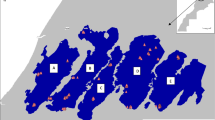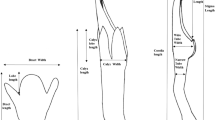Abstract
Castanopsis acuminatissima (Bl.) A. DC. is one of a number of ‘framework species’ which are being planted to restore seasonally dry tropical forests in northern Thailand. This study describes the level of microsatellite variation within and among three populations of this species in three National Parks in northern Thailand: Doi Suthep-Pui, Doi Inthanon and Jae Sawn, using published primers developed for Castanopsis cuspidata var. sieboldii Nakai. The five microsatellite loci employed in this study detected a total of 54 alleles (n = 72). The informativeness of the microsatellite loci varied from six to 18 alleles, with an average of 10.8 alleles found over all loci. The mean observed heterozygosities in the three populations showed no significant deviations from Hardy-Weinberg expectations. The vast majority of genetic diversity was contained within the populations, with no significant differentiation between them (FST = 0.006). Algorithms were designed to capture microsatellite diversity, and the rationale for using microsatellite markers to inform genetic conservation is discussed. The implications for seed collection of C. acuminatissima for forest restoration are also discussed.
Similar content being viewed by others
References
Aldrich P.R., Hamrick J.L., Chavarriaga P. and Kochert G. 1998. Microsatellite analysis of demographic genetic structure in fragmented populations of the tropical tree Symphonia globulifera. Mol. Ecol. 7: 933–944.
Barrett S.C.H. and Kohn J.R. 1991. Genetic and evolutionary consequences of small population size in plants: implications for conservation. In: Falk D.A. and Holsinger K.E. (eds), Genetics and Conservation of Rare Plants. Oxford University Press, pp. 3–30.
Blakesley D., Elliott S., Kuarak C., Navakitbumrung P., Zangkum S. and Anusarnsunthorn V. 2002. Propagating framework tree species to restore seasonally dry tropical forest: implications of seasonal seed dispersal and dormancy. Forest Ecol. Manage. 164: 31–38.
Brown A.H.D. 1978. Isozymes, plant population genetic structure and genetic conservation. Theor. Appl. Genet. 52: 145–157.
Elliott S., Kuarak C., Navakitbumrung P., Zangkum S., Anusarnsunthorn V. and Blakesley D. 2002. Propagating framework trees to restore seasonally dry tropical forest in northern Thailand. New Forests 23: 63–70.
Ennos R.A., Worrell R., Arkle P. and Malcolm D.C. 2000. Genetic variation and conservation of British native trees and shrubs. Forestry Commission Technical Paper 31. 38p.
FAO 1997. State of the World's Forests.
FAO 2001. Forest genomics for conserving adaptive genetic diversity unpublished.
Forest Restoration Research Unit 2000. Tree Seeds and Seedlings for Restoring Forests in Northern Thailand. In: Kerby J., Elliott S., Maxwell J.F., Blakesley D. and Anusarnsunthorn V. (eds), Biology Department, Science Faculty, Chiang Mai University, Thailand 152 p.
Goosem S.P. and Tucker N.I.J. 1995. Repairing the Rainforest — Theory and Practice of Rainforest Re-establishment in North Queensland's Wet Tropics. Wet Tropics Management Authority, Cairns, 71 p.
Gutierrez-Espeleta G.A., Hedrick P.W., Kalinowski S.T., Garrigan D. and Boyce W.M. 2001. Is the decline of desert bighorn sheep from infectious disease the result of low MHC variation? Heredity 86: 439–450.
Hamrick J.L. and Godt M.J.W. 1990. Allozyme diversity in plant species. In: Brown A.H.D., Clegg M.T., Kahler A.L. and Weir B.S. (eds), Plant Population Genetics, Breeding and genetic Resources. Sinauer Associates Inc., Sunderland, MA, pp. 43–46.
Hedrick P.W. 2001. Conservation genetics: where are we now? Trends in Ecol. and Evol. 16: 629–636.
Hedrick P.W., Parker K.M. and Lee R.N. 2001. Using microsatellite and MCH variation to identify species, ESUs, and MUs in the endangered Sonoran topminnow. Mol. Ecol. 10: 1399–1412.
Khadari B., Hochu I., Santoni S. and Kjellberg F. 2001. Identification and characterization of microsatellite loci in the common fig (Ficus carica L.) and representative species of the genus Ficus. Mol. Ecol. Notes 1: 191–193.
Kashi Y. and Soller M. 1999. Functional roles of microsatellites and minisatellites. In: Goldstein D.B. and Schlotterer C. (eds), Microsatellites: Evolution and Application. Oxford University Press, pp. 10–23.
Kashi Y., King D. and Soller M. 1997. Simple sequence repeats as a source of quantitative genetic variation. Trends in Genet. 13: 74–78.
King D. and Soller M. 1999. Variation and fidelity: the evolution of simple sequence repeats as functional elements in adjustable genes. In: Wasser S.P. (ed.), Evolutionary Theory and Processes: Modern Perspectives. Kluwer, pp. 65–82.
Konuma A., Tsumura Y., Lee C.T., Lee S.L. and Okuda T. 2000. Estimation of gene flow in the tropical-rainforest tree Neobalanocarpus heimii Diperocarpaceae., inferred from paternity analysis. Mol. Ecol. 9: 1843–1852.
Krusche D.M. and Beburek T.H. 1991. Conservation of forest gene resources as related to sample size. Forest Ecol. Manage. 40: 145–150.
Lamb D., Parrotta J., Keenan R. and Tucker N.I.J. 1997. Rejoining habitat remnants: restoring degraded rainforest lands. In: Laurence W.F. and Bierrgaard R.O. Jr. (eds), Tropical Forest Remnants: Ecology, Management and Conservation of Fragmented Communities. University of Chicago Press, Chicago, Il, pp. 366–385.
Li Y.-C., Fahima T. and Peng J.H. et al. 2000a. Edaphic microsatellite DNA divergence in wild emmer wheat,Triticum dicoccoides, at a microsite: Tabigha, Israel. Theor. Appl. Genet. 101: 1029–1038.
Li Y.-C., Röder M.S. and Fahima T. et al. 2000b. Natural selection causing microsatellite divergence in wild emmer wheat at the ecologically variable microsite at Ammiad, Israel. Theor. Appl. Genet. 100: 985–999.
Li Y.-C., Korol A.B., Fahima T., Beiles A. and Nevo E. 2002. Microsatellites: genomic distribution, putative functions and mutational mechanism: a review. Mol. Ecol. 11: 2453–2465.
Li Y.-C., Korol A.B., Fahima T., Beiles A. and Nevo E. 2002. Microsatellites: genomic distribution, putative functions and mutational mechanisms. Forest Ecol. Manage. (in press).
Marcotte E.M., Pellegrini M., Yeates T.O. and Eisenberg D. 1999. A census of protein repeats. J. Mol. Biol. 293: 151–160.
Moxon E.R. and Wills C. 1999. DNA microsatellites: Agents of Evolution? Scientific Amer. 280: 94–99.
Murray M.G. and Thompson W.F. 1980. Rapid isolation of high molecular weight plant DNA. Nucleic Acid Res. 8: 4321–4325.
Marshall D.R. and Brown A.H.D. 1975. Optimum sampling strategies in genetic conservation. In: Frankel O.H. and Hawkes J.G. (eds), Crop Genetic Resources for Today and Tomorrow. Cambridge University Press, London, pp. 53–80.
Namkoong G., Kang H.C. and Brouard J.S. 1988. Tree breeding: principles and strategies. Monograph Theor. Appl. Genet. 11.
Nauta M.J. and Weissing F.J. 1996. Constraints on allele size at microsatellite loci: implications for genetic differentiation. Genetics 143: 1021–1032.
Pakkad G., James C., Torre F., Elliott S. and Blakesley D. 2003. Genetic variation of Prunus cerasoides D. Don, a framework tree species in northern Thailand. New Forest (in press).
Payne and other Genstat Committee members R.W. 2000. Introduction. In: Harding S., Lane P., Murray D. and Payne R. (eds), Genstat for Windows. 5th edn. 204 pp.
Raymond M. and Rousset F. 1995. GENEPOP version 1.2.: Population genetics software for exact tests and oecumenism. J. Heredity 86: 248–249.
Sambrook J., Fritsch E.F. and Manniatis J. 1989. Molecular Cloning. A laboratory manual. Cold Spring Harbour Laboratory Press, New York.
Schlötterer C. and Wiehe T. 1999. Microsatellites, a neutral marker to infer selective sweeps. In: Goldstein D.B. and Schlotterer C. (eds), Microsatellites: Evolution and Application. Oxford University Press, pp. 238–247.
Tucker N.I.J. and Murphy T.M. 1997. The effects of ecological rehabilitation on vegetation recruitment: some observation from the Wet Tropics of North Queensland. Forest Ecol. Manage. 99: 133–152.
Ueno S., Yoshimaru H., Kawahara T. and Yamamoto S. 2000. Isolation and microsatellite markers in Castanopsis cuspidata var. sieboldii Nakai from an enriched library. Mol. Ecol. 9: 1188–1190.
Wagner H.W. and Sefc K.M. 1999. IDENTITY 1.0. Centre for Applied Genetics, University of Agricultural Sciences, Vienna, Austria.
White G. and Powell W. 1997. Isolation and characterization of microsatellite loci in Swietenia humilis Meliaceae: an endangered tropical hardwood species. Mol. Ecol. 6: 851–860.
Wren J.D., Forgacs E. and Fondon J.W. et al. 2000. Repeat polymorphisms within gene regions: Phenotypic and evolutionary implications. Am. J. Hum. Genet. 67: 345–356.
Wright S. 1965. The interpretation of a population structure by F-statistics with special regard to systems of mating. Evolution 19: 395–420.
Yanchuk A.D. 2001. A quantitative framework for breeding and conservation of forest tree genetic resources in British Columbia. Can. J. Forest Res. 31: 566–576.
Author information
Authors and Affiliations
Corresponding author
Rights and permissions
About this article
Cite this article
Blakesley, D., Pakkad, G., James, C. et al. Genetic diversity of Castanopsis acuminatissima (Bl.) A. DC. in northern Thailand and the selection of seed trees for forest restoration. New Forests 27, 89–100 (2004). https://doi.org/10.1023/A:1025016331835
Issue Date:
DOI: https://doi.org/10.1023/A:1025016331835




